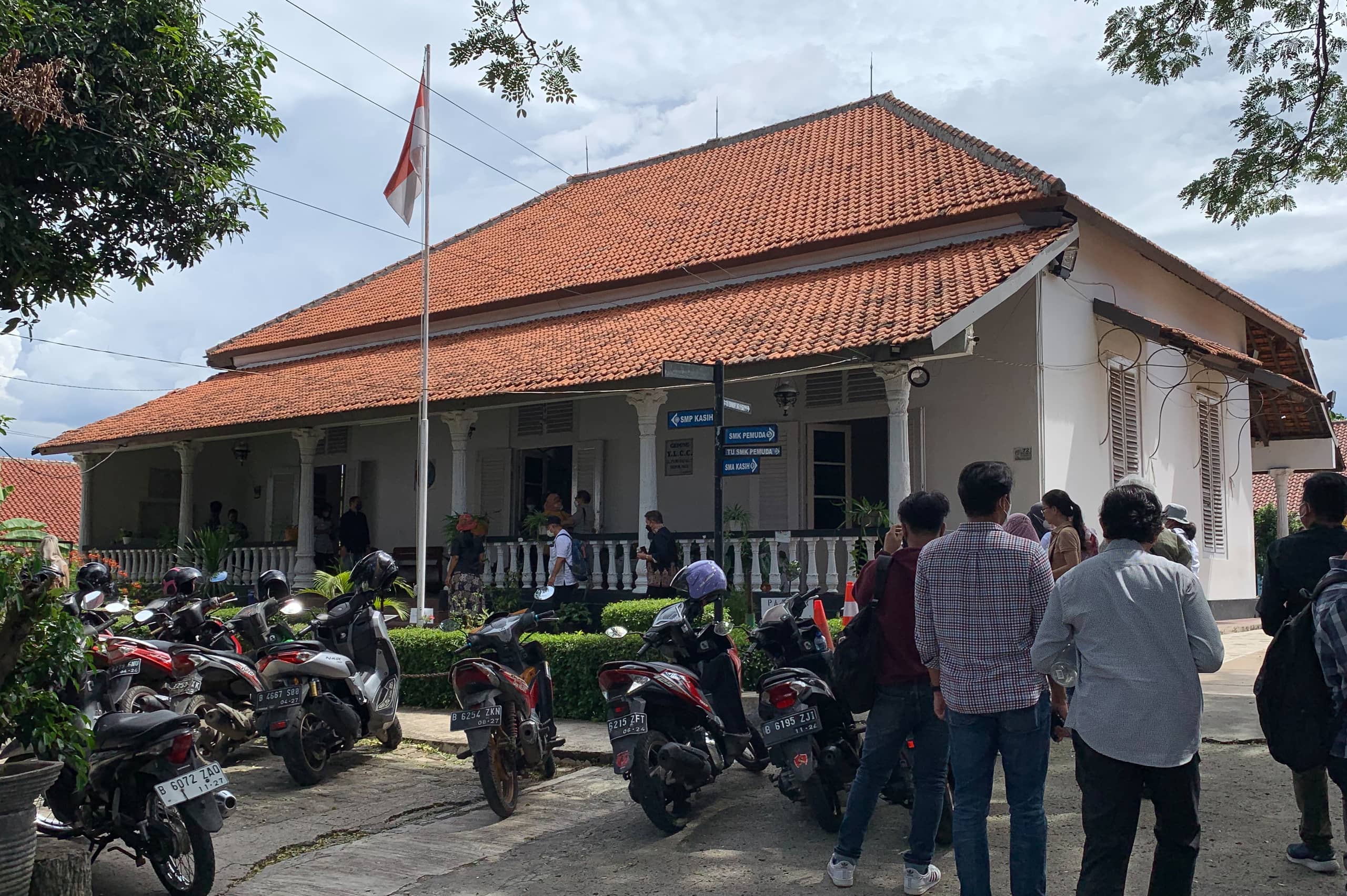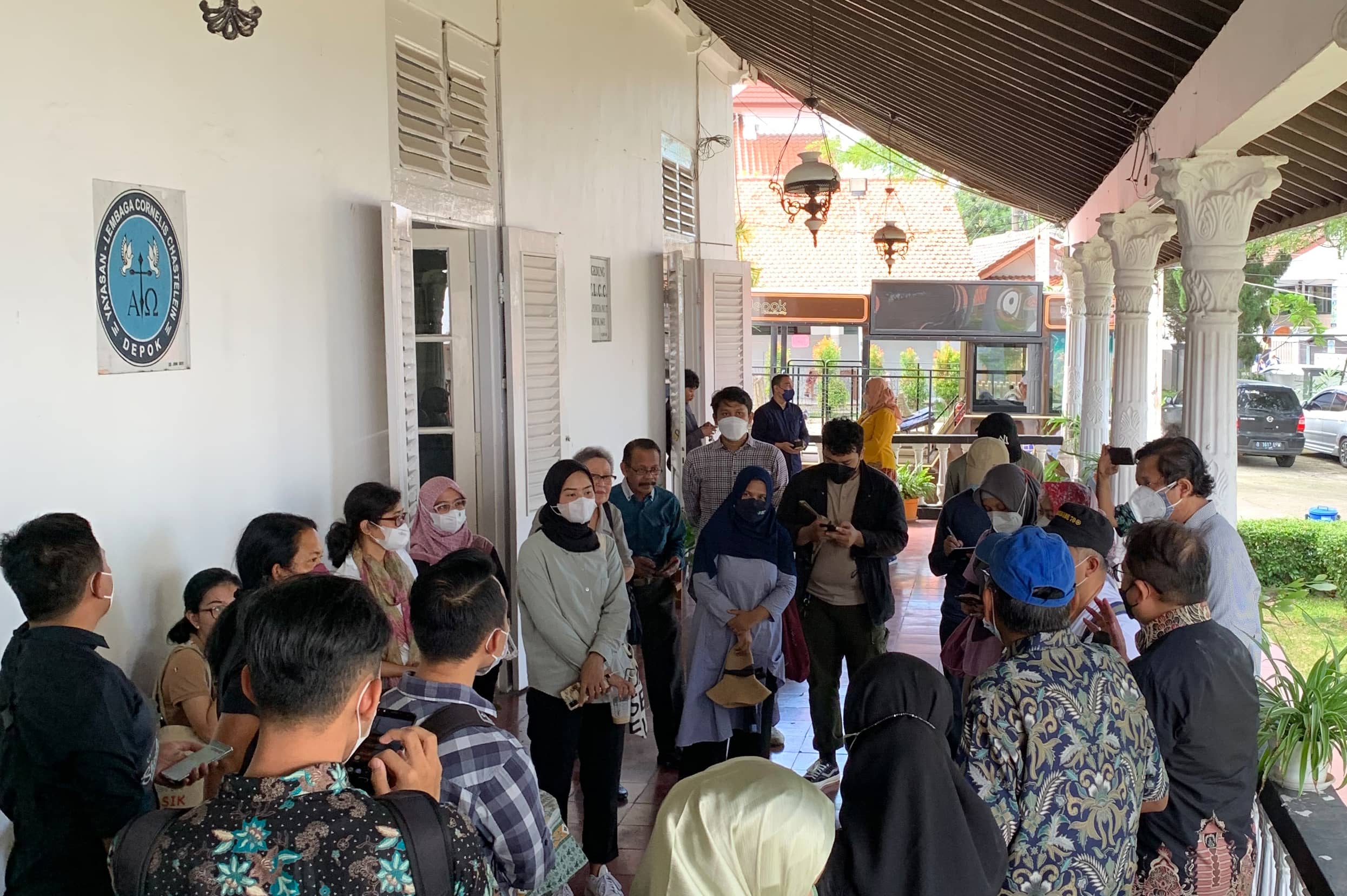The following text was published in the Cultural Heritage Agency's (RCE) publication Tijdschrift in August 2023.
In the historic centre of the Indonesian city of Depok, it is surprising to discover from whom its inhabitants are descended. At the same time, historical buildings are disappearing slowly and large-scale urbanisation is advancing. Because of this, strategies have been developed to revitalise old Depok taking into account its three centuries of history.
Written by Peter Timmer and Jacqueline Rosbergen.
Over two and a half million inhabitants live in Depok. The city is situated in the metropolitan region of Jakarta and along its crowded roads many high-rise buildings have been built and large shopping malls are arising. It seems only a matter of time before the old centre, or Depok Lama as they say in Indonesia, will be affected by the consequences of this development. Therefore the University of Indonesia recently organised a workshop on integrated conservation and development of this remarkable area. Amongst other parties, the Cultural Heritage Agency of the Netherlands (RCE) participated in this event.
It is an understatement to consider Depok Lama as remarkable. The older generations that live there still speak Dutch fluently. Dutch traditions like celebrating Sinterklaas are well known and in several houses one can find Delft blue pottery. Football matches involving the Dutch national team are followed with great enthusiasm. Yet these people from Depok are not Dutch, they are Indonesian. What binds them together is their common past. Many are descendants of 150 enslaved people, brought to Depok by Cornelis Chastelein, an Administrator of Council of the Dutch East India Company (VOC).
Large country houses
Chastelein was part of a colonial elite that owned large pieces of land and built large country houses in the surroundings of Batavia (the old Dutch name for Jakarta). Since 1696 he obtained, amongst other things, the land of Depok consisting of over 1.250 acres. This particular piece of land was cultivated for agriculture and habitation by his people. They were brought there from Coromandel in India, Bengal, Makassar on South Sulawesi, but their majority originated from Bali. In his will, Chastelein stipulated that they were all freed after his death and they inherited the land of Depok as a communal property. In this way, their descendants evolved into a community of twelve families after Chastelein’s death in 1714.

A former vicarage houses the foundation YLCC that takes care of its cultural heritage in the historic centre of Depok 
YLCC explaining about the history of Depok at the vicarage’ porch
The community was given autonomy, with Depok Lama as its residence, surrounded by farmlands, where the local population lived. For centuries, Depok was a private property. In the Dutch East Indies, the people of Depok had a privileged position. Because of this, they were strongly focused on the Dutch colonial society. But after casting off the colonial yoke, the Indonesian government dissolved Depok in 1952 and disowned it. As a symbolic gesture, some pieces of land and some buildings were returned to the community. For taking care of the Depok community and its cultural heritage, a foundation was established, called Yayasan Lembaga Cornelis Chastelein (YLCC). It still functions for that purpose to this day.
The oldest church of Depok is without a doubt the most striking building here
Drastic changes
Jan-Karel Kwisthout, descendant of one of these twelve families, wrote several publications about their history. Soon his latest book Drie eeuwen Depok: Erfenis van Cornelis Chastelein (1657-1714) aan zijn vrijgemaakte christenslaven op West-Java will be published. ‘Depok underwent a transformation,’ Kwisthout tells, ‘that has not ended yet. From an agrarian community, it became a modern city. This led to drastic changes. Many old buildings have been torn down.’ Since Indonesia’s independence the community was stigmatised as Dutch Depok people. Their heritage and identity were seen as a symbol of past colonial rule. ‘Because of this, the violent revolutionary years during the decolonisation process were traumatic for many of them,’ Kwisthout says. ‘While many left their birth place, their sense of identity remained unwavering, anchored in their collective memory. Moreover, their history is inseparable from Depok’s founder Cornelis Chastelein.’
The oldest church building of Depok Lama that still exists, largely dates from around 1845 and is without a doubt the most striking building in the area. The twelve family names have been engraved in twelve wooden church doors. The former vicarage, that nowadays houses the YLCC foundation, is located adjacent to it. Its walls are adorned with pictures of Chastelein and maps of the old Depok. At a round table meetings are held, prayers are said, and songs are sung. Tags with the names of the twelve families are attached to the backs of the chairs that are surrounding the table. And across the street there is a community building which also serves as a school.
Hip cafés
Somewhat further along the road, houses in a typical colonial style can be found. The lush surroundings and large gardens of the past have often given way to new houses. Unused public buildings are present as well in Depok Lama. Former architecture students have creatively transformed some buildings into hip cafés. Also remaining from the era of Chastelein, is a small forest of approximately six-acres. Cornelis Chastelein stipulated in his will that this primeval forest should be preserved. It became Java’s oldest natural reserve in 1913.
In November of last year, Indonesian students and young professionals from the fields of architecture and landscaping took part in the workshop. They followed a tool to revitalise historic cities, the Historic Urban Landscape (HUL) Quick Scan Method. This method has been developed by the University of Indonesia, de Universitas Trisakti, the Institut Pertanian Bogor, the Dutch consultancy Heritage Hands-on and the RCE. The Chastelein-foundation, the government and entrepreneurs discussed workshop presentations by the participants. The Dutch ambassador Lambert Grijns, an urban planner by education, also attended the workshop, out of interest for the area. This interaction created a dynamic atmosphere and the awareness that Depok deserves more attention.
Young Indonesians discuss the future of old Depok in café ARTiVATOR
Green qualities
For many Indonesian participants it was special to experience how alive and tangible history is in Depok Lama. The presented plans are aimed at the recovery of green qualities, new life for old buildings and tourist development. Two ideas stuck out. For the forest, it was put forward to redesign its outskirts into a recreational area and involve the surrounding neighbourhood in management of the nature reserve. The inner core should be kept reserved for scientific research and higher education.
Another fascinating idea is aimed at a thriving future with a multicultural character of the entire old town. During the workshop it turned out that the history and traditions of the local population of Depok Lama were not very well known. Sometimes, these were also difficult to understand, or riddled with political and religious misconceptions and sensitivities.
Because of this, the participants proposed to install an Urban Living Lab. The lab should focus on innovative means of storytelling to achieve social and cultural connections, that can serve as a foundation for developing Depok Lama’s heritage sites.
This fits seamlessly within the observations of Jan-Karel Kwisthout: Mutual tolerance, sense of community and interconnections have been central here for three centuries. The identity of the twelve families has been shaped by the past and provides a basis for their future. Preservation, sharing and passing down are important. For what follows is always connected to what came before.
Peter Timmer, advisor cultural heritage at the Cultural Heritage Agency of the Netherlands, and Jacqueline Rosbergen, independent advisor heritage and development, took part in the workshop.